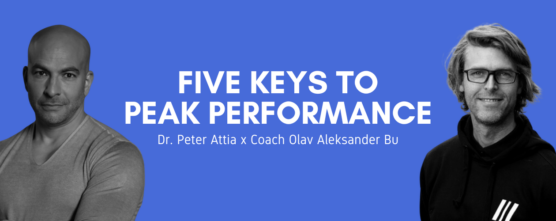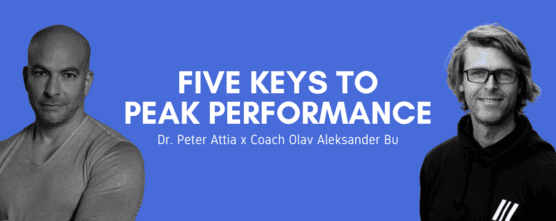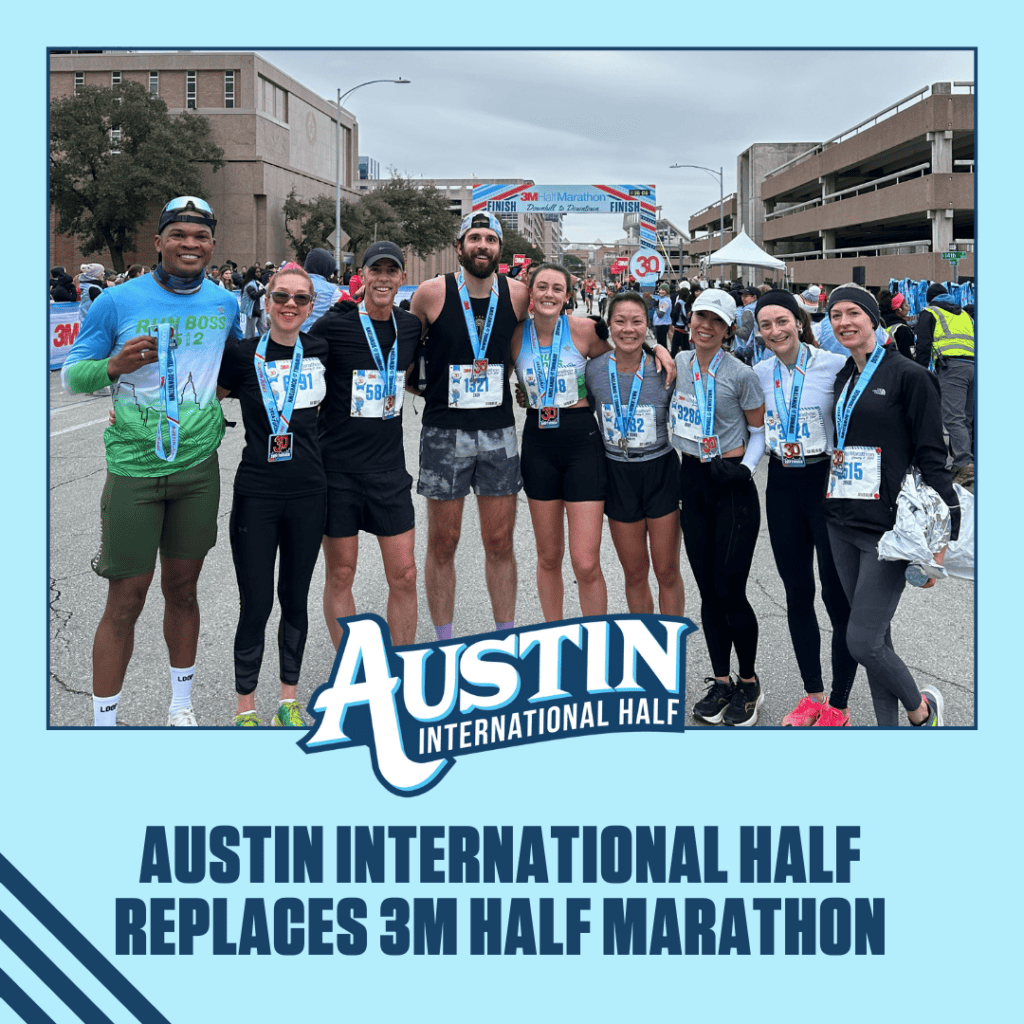
Medical expert in longevity, Peter Attia, M.D., interviewed sport scientist and triathlon coach Olav Aleksander Bu in a nearly three-hour long episode of his podcast The Drive that aired March 18, 2024.
Bu is the head of performance for Norway Triathlon and famously coaches both Olympic Champion Kristian Blummenfelt and two-time Ironman World Champion Gustav Iden. Bu is highly regarded for his knowledge and application of exercise physiology, specifically in terms of helping elite athletes reach their running goals and peak performance. Trained as an engineer, Bu, has a knack for numbers and a heavy bent towards using data to guide his athletes.
“When you do a lot of training it can become monotonous, but when you bring in instruments with a clear purpose of what you want to measure, it’s a good way to increase focus. It becomes a tool to bring our attention to the workout,” Bu said in a 2023 interview with Triathlete.
Though the podcast talked mostly about triathlon, and specifically the swimming and cycling legs of the sport, there was still plenty that single-sport runners could glean from Bu’s expertise.
Here are our five takeaways from the lengthy conversation:
1. VO2Max is not the most accurate predictor of performance.
Context matters here: Bu explains that raising your VO2 Max is still a goal in training, but it’s not a marker that will actually predict endurance performance. That’s because VO2 Max is measured as a product of maximum output over a short period of time.
“Simply because we have a limitation in how much energy we can turn around per day, per week, and so on, sustainably, it basically means that we have to focus more on the specificity that we’re looking to excel in. And yes, VO2 Max will be the best predictor, but not necessarily having the highest number.”
Translation for runners: You need to build your engine for the race you’re competing in. What your “engine” needs for a 400-meter race will not be the same for a 10K or for a half marathon distance.
A more precise way to think about and predict your capabilities would be in terms of power as a function of time — such as the power at which you can run for five minutes versus the power you can run for 60 minutes.
Power in running is typically measured in watts using power meters. Just like how the wattage of a lightbulb indicates how much power is needed to produce light, your running wattage indicates how much power you need to perform to a certain standard.
If you don’t have a power meter, other running devices, like Garmin watches for example, have their own internal method for estimating power using different equations.
2. Portable, available devices are actually pretty good at measuring VO2 and total energy expenditure.
Attia and Bu have access to lab equipment as a way to dial cardiopulmonary biomarkers and track progress over time. But what of the rest of us?
Well, Bu said indirect calorimetry devices that test cardiopulmonary and metabolic biomarkers at home are surprisingly accurate — and definitely accurate enough for the layathlete. (Yes, you can measure your VO2 Max at home, but it’s not as accurate.)
Bu is a fan of VO2 Master, which retails for $6,295 (remember, he trains elite athletes, but that doesn’t mean the bougiest of us can’t also indulge). Yes, there are boutique labs where you can go test your VO2Max without investing in equipment, but the power of the information is tracking these measurements over time versus a single testing session.
If you’re going to dive into these metrics yourself, you need to measure regularly, according to Bu. That’s where the strength of data comes from — in looking at the trends and understanding how you’re progressing.
Another at-home device you may have heard of is Lumen, which tracks your CO2 concentration to flag the type of fuel your body is using, but does not measure VO2.
Translation for runners: If you want to invest in equipment to dive into your specific metrics and try to biohack your running, the products are out there.
But this is probably overkill for the majority of us.
3. We’ll never be able to take in as much oxygen and carbohydrates as what our mitochondria are capable of using.
This podcast episode talked mostly about peak performance. Along those lines, Attia wanted to know where we are limited, physiologically. It was in answering this question Bu made an interesting point about VO2 Max and muscle oxidative capacity.
Some basics before we dive into Bu’s point. Maybe you’ve seen the recent trend in mitochondrial training to boost performance and the rise of supplements promoting mitochondrial support. Mitochondria are organelles that transform food and oxygen into energy within the cell. So, in theory, improving your mitochondria should improve your aerobic performance. And studies do show that exercise is very beneficial to mitochondria.
Bu notes that, when isolating the mitochondria on its own through a muscle biopsy, respiration is doubled or even tripled compared to maximal output when testing VO2 Max traditionally. Meaning, the oxygen mitochondria is capable of using, compared to what we’re able to pump to it, is an extreme disparity.
So where is the limitation happening if it’s not in the mitochondria’s capacity?
“Getting the blood, the oxygen, the hemoglobin transported to the cells is the most important thing. It’s more of a central limitation than a peripheral limitation,” said Bu.
The same, Bu said, is also true of carbohydrates. What the mitochondria can process is so much higher than what we’re able to physically take in.
With that notion in mind, it would be interesting to know what Bu thinks about the concept of training to boost the mitochondria.
4. Experimentation and play makes you a better athlete.
The longer we spend in our sport, the more likely we may become set in our ways.
Think about it: When you first started training you probably had a whole host of negative experiences you had to solve for — runner’s trots, dehydration, various minor injuries, the wrong shoes, etc. You may have landed on your “perfect” pre-run meal, warmup, training routine, and favorite shoes to keep these inconveniences at bay, but what potential improvements are you missing out on by not continuing to tweak?
Bu says he thinks this is why some people become better and others not. “Because one thing that we very often tend to lose as we get older or go through different training is we lose that ability to play. Going out and playing is one of the best ways to learn, actually, what influences us.”
Aside from signing up for a fun run, there are other ways you can insert play into your training: How can you experiment with your training metrics? Cadence? Pace? Heart rate? Power? Of course there is always risk in making changes. You may bonk. You may injure yourself. But what if you don’t? What if the element you changed is the reason you PR?
5. Consistency is undervalued.
Yes, the last point might have argued not to get complacent. But at the same time, your training needs to be consistent in order to improve.
What does that mean? It means getting on a schedule and sticking to it.
It also means not going so hard that you burn yourself out or injure yourself running. “It means you need to leave a little bit in the reserve,” he said, in order to go back out and train day after day.
And, of course, we can’t talk about consistency without the psychological elements that keep us consistent — “joy of exercise and a sense of achievement in your training,” as Bu put it.
Though much of his conversation with Attia is full of jargon and equations, Bu boils it all down to the deeply relatable sentiment that none of this matters if you’re not inspired to get out of bed and hit the road, track, or trail.
____
Want to train using Bu’s methods? This is the best explanation of the way Bu uses data driven intervention in training that we’ve seen. Like Bu said, go ahead and experiment. See what works for you.





